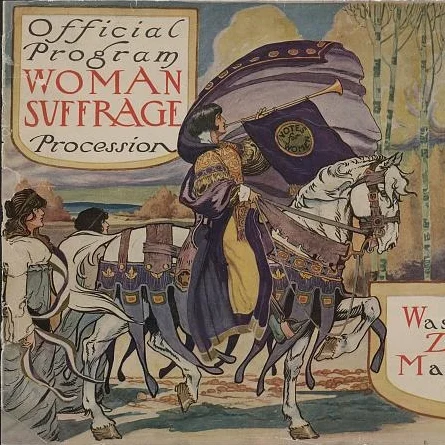In 1872, woman’s rights activist Susan B. Anthony made the national news when she was arrested for casting a ballot in the presidential election. An illustrated newspaper, The Daily Graphic, featured her on its cover (see left image). The engraver copied one of Anthony’s popular, inexpensive photographic portraits so that readers would recognize her (see right image). The satirical version of Anthony wears a patriotic top hat and a scandalously short dress that reveals masculine boots. She leans on an umbrella—reminiscent of a military officer’s sword—in an unladylike stance. Behind her, a female police officer watches over women at a political rally, while two men with a baby and food basket suggest one of the dire consequences of women’s votes: men will have to take on women’s domestic responsibilities.
By the time The Daily Graphic printed this illustration, popular imagery had lampooned activists as masculine women who threatened American society for over a century. Anthony worked to improve the movement’s public image in response to these cartoons. She reprimanded newspaper editors who printed portraits of suffragists that were “too horrible to have our names written under them.” Her colleague, Elizabeth Cady Stanton, helped her promote an iconography of leaders to prove they were a “remarkably fine looking body of women!!”
Images of Change will be the first book to demonstrate the centrality of visual politics—the strategic use of images to promote a cause or candidate—to women’s campaigns. My manuscript examines the political pictures employed by reformers and their opponents throughout the long nineteenth century. Reformers used images to contest gender roles and women’s relationships with the state, while their opponents used them to reinforce existing ones. Suffragists had to change dominant perceptions of political women to win the vote. Reformers initially incorporated visual strategies from other movements and, ultimately, coordinated innovative campaigns that laid the foundations for modern ones.
This book begins with the promise of political rights that accompanied American independence and ends with the passage of the 19th Amendment, which granted women the vote, in 1920. From early woodblock engravings to newspaper halftones, activists took advantage of improvements in image technology and the power of popular imagery to revolutionize politics. Widely distributed pictures offered a fast, inexpensive way to influence Americans throughout the expanding nation. Political images were at the heart of the development of a shared national visual language, composed of symbols and gendered conventions. This language helped fuel the rise of mass society and highly visual culture of 21st-century life.


